tunnels
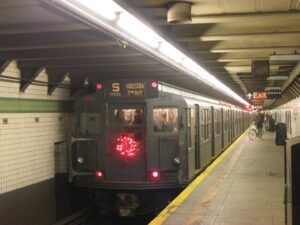 In areas of the country that are more rural, most everyone has their own car, and while we have bus systems, the majority of people drive themselves to do their errands and such. In large metropolis places, like New York City, however, where parking is hard to find, and costs a fortune, many people choose not to own a vehicle. That said, getting around there is not as easy as it is for those of us who simply go out and get in our car, and drive away. For New York City the best solution was to build a subway. As most people know, a subway is a rapid transit system. The one in New York City serves four of the five boroughs of New York City, including the Bronx, Brooklyn, Manhattan, and Queens. The subway is operated by is the New York City Transit Authority (NYCTA), which is controlled by the Metropolitan Transportation Authority (MTA) of New York. In 2016 alone, an average of 5.66 million passengers used the system every day, making it the busiest rapid transit system in the United States and the seventh busiest in the world.
In areas of the country that are more rural, most everyone has their own car, and while we have bus systems, the majority of people drive themselves to do their errands and such. In large metropolis places, like New York City, however, where parking is hard to find, and costs a fortune, many people choose not to own a vehicle. That said, getting around there is not as easy as it is for those of us who simply go out and get in our car, and drive away. For New York City the best solution was to build a subway. As most people know, a subway is a rapid transit system. The one in New York City serves four of the five boroughs of New York City, including the Bronx, Brooklyn, Manhattan, and Queens. The subway is operated by is the New York City Transit Authority (NYCTA), which is controlled by the Metropolitan Transportation Authority (MTA) of New York. In 2016 alone, an average of 5.66 million passengers used the system every day, making it the busiest rapid transit system in the United States and the seventh busiest in the world.
As New York City grew (it currently has 10 times the amount of people as Wyoming – the smallest state by population), it became obvious that there was going to have to be a public transport system. Work began on  the New York Subway on March 24, 1900, and the first underground line opened on October 27, 1904. The opening of the subway was almost 35 years after the opening of the first elevated line in New York City, which became the IRT Ninth Avenue Line. By the time the first subway opened, the two elevated lines had been consolidated into two privately owned systems, the Brooklyn Rapid Transit Company (BRT, later Brooklyn–Manhattan Transit Corporation, BMT) and the Interborough Rapid Transit Company (IRT). All lines built for the IRT and most lines for the BRT were built by the city and leased to the companies after 1913. When the first line of the city-owned and operated Independent Subway System (IND) opened in 1932, it was intended to compete with the private systems and replace some of the elevated railways. The problem was that it was required to be run “at cost,” By necessity, the fares were up to double the five-cent fare, that was popular at the time…thereby, completely defeating the intended purpose.
the New York Subway on March 24, 1900, and the first underground line opened on October 27, 1904. The opening of the subway was almost 35 years after the opening of the first elevated line in New York City, which became the IRT Ninth Avenue Line. By the time the first subway opened, the two elevated lines had been consolidated into two privately owned systems, the Brooklyn Rapid Transit Company (BRT, later Brooklyn–Manhattan Transit Corporation, BMT) and the Interborough Rapid Transit Company (IRT). All lines built for the IRT and most lines for the BRT were built by the city and leased to the companies after 1913. When the first line of the city-owned and operated Independent Subway System (IND) opened in 1932, it was intended to compete with the private systems and replace some of the elevated railways. The problem was that it was required to be run “at cost,” By necessity, the fares were up to double the five-cent fare, that was popular at the time…thereby, completely defeating the intended purpose.
While the city tried to keep the elevated system running too, and succeeded to a degree, many were had to be closed, because it became too expensive to maintain them. Graffiti, crime, and dilapidation became common. The New York City Subway had to make many service cutbacks and defer necessary maintenance projects just to stay solvent. In the 1980s an $18 billion financing program for the rehabilitation of the subway began. Today, the subway systems remain an important part of the transport system, in New York City. They are also vulnerable to attack, as well as simple maintenance problems. The September 11 attacks prove this without question. The attacks resulted in service disruptions, particularly on the IRT Broadway–Seventh Avenue Line, which ran directly underneath the World Trade Center. Several sections were crushed, requiring suspension of 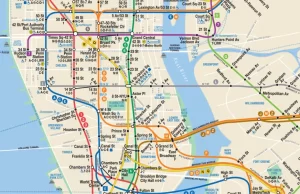 service on that line south of Chambers Street. Work began immediately to repair the damage, and by March 2002, seven of the closed stations had been rebuilt and reopened. All but one of them. Then, on September 15, 2002, that one also reopened with full service along the line. Since the 2000s, expansions include the 7 Subway Extension that opened in September 2015, and the Second Avenue Subway, the first phase of which opened on January 1, 2017. However, at the same time, under-investment in the subway system led to a transit crisis that peaked in 2017. Subways will most likely always be an important part of transportation, especially in big cities. Nevertheless, it will also always have its vulnerabilities.
service on that line south of Chambers Street. Work began immediately to repair the damage, and by March 2002, seven of the closed stations had been rebuilt and reopened. All but one of them. Then, on September 15, 2002, that one also reopened with full service along the line. Since the 2000s, expansions include the 7 Subway Extension that opened in September 2015, and the Second Avenue Subway, the first phase of which opened on January 1, 2017. However, at the same time, under-investment in the subway system led to a transit crisis that peaked in 2017. Subways will most likely always be an important part of transportation, especially in big cities. Nevertheless, it will also always have its vulnerabilities.
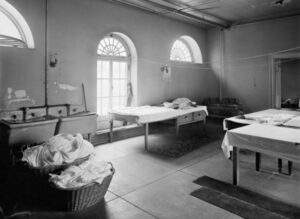
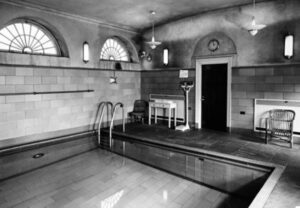 Construction began on the White House on October 13, 1792, and was finally finished on November 1, 1800. Construction was slower in those days, because they didn’t have the equipment we have today. The current White House has 132 rooms. The original White House had 100 rooms. The White House has 54,900 square feet. The White House sits on 18 acres of land. It all it is an impressive building, but there is more to it than just that.
Construction began on the White House on October 13, 1792, and was finally finished on November 1, 1800. Construction was slower in those days, because they didn’t have the equipment we have today. The current White House has 132 rooms. The original White House had 100 rooms. The White House has 54,900 square feet. The White House sits on 18 acres of land. It all it is an impressive building, but there is more to it than just that.
There have been a number of rooms that began as one thing, only to become something else later on. One of the rooms that has had a couple of identities is the Press Briefing Room. These days it is the James S. Brady Press Briefing Room. It was so named after White House Press Secretary James Brady, who was shot and permanently disabled during the assassination attempt on President Reagan. That room, located in the West Wing of the White House was not always such a necessary room, mostly because press briefings are really more of a modern-day thing. The room has always existed, however. In 1909, it was the White House laundry, and during President Truman’s time in office (April 12, 1945 – January 20,1953) it was the White House pool.
By 1950, the White House was 150 years old and in a serious state of disrepair. In order to make is inhabitable 
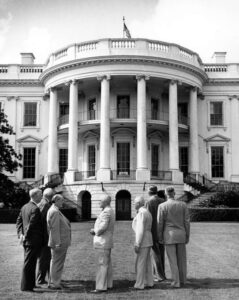 again, the entire building was gutted and rebuilt to make it more stable. It also seemed like a good time to improve on its design, so some improvements and additions were made. White House architect Lorenzo Simmons Winslow designed and built an air raid shelter under the East Terrace on the orders of naval aide Rear Admiral Robert Dennison. There had been a bomb shelter before, but it was built in 1942 and with the invention of the atomic bomb, the old shelter was not strong enough to withstand such an assault. Because little research had been conducted into how to withstand such an assault, construction of the shelter took more than two years and required the removal of the East Terrace entirely. Unfortunately, the 1952 shelter was rendered obsolete when the first test produced a force of 10.4 million tons. This shelter was designed to withstand a force of only 30,000 tons, so this would never work.
again, the entire building was gutted and rebuilt to make it more stable. It also seemed like a good time to improve on its design, so some improvements and additions were made. White House architect Lorenzo Simmons Winslow designed and built an air raid shelter under the East Terrace on the orders of naval aide Rear Admiral Robert Dennison. There had been a bomb shelter before, but it was built in 1942 and with the invention of the atomic bomb, the old shelter was not strong enough to withstand such an assault. Because little research had been conducted into how to withstand such an assault, construction of the shelter took more than two years and required the removal of the East Terrace entirely. Unfortunately, the 1952 shelter was rendered obsolete when the first test produced a force of 10.4 million tons. This shelter was designed to withstand a force of only 30,000 tons, so this would never work.
In addition to the new nuclear shelter, a tunnel was added. These days those tunnels are big in the news, but back then, they were probably a little-known addition. This reinforced concrete channel ran from the West Wing to the East Wing. Though not enough to stop a nuclear incident itself, the tunnel allowed quick passage from one end of the White House to the other, as well as access to the new air raid shelter. The presence of the tunnel demonstrates just how concerned the Truman White House was about securing itself against air assaults at that volatile time in history. That first tunnel inside the White House isn’t the only underground feature. In 1987, a second tunnel was built under the name Project ZP. That tunnel, accessible from a secret passage 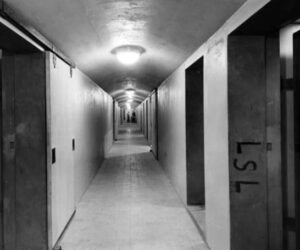
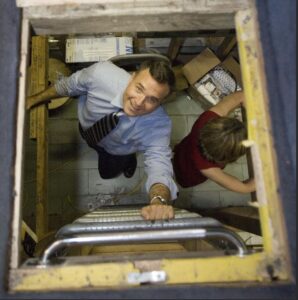 within the Oval Office, leads to the basement of the East Wing and on to the Treasury Building. Its construction, which was largely secret, created a large sinkhole in the White House rose garden. The tunnel was reportedly built to quickly get the president out of the office during an incursion, but it was also used at least once to sneak former president Richard Nixon into a foreign policy meeting. I’m sure there are other changes to the White House, that we are not privy to, and may never know, because there are always secrets in this kind of building.
within the Oval Office, leads to the basement of the East Wing and on to the Treasury Building. Its construction, which was largely secret, created a large sinkhole in the White House rose garden. The tunnel was reportedly built to quickly get the president out of the office during an incursion, but it was also used at least once to sneak former president Richard Nixon into a foreign policy meeting. I’m sure there are other changes to the White House, that we are not privy to, and may never know, because there are always secrets in this kind of building.
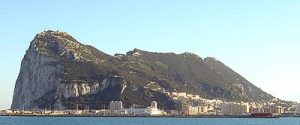 After reading about the rescue of Allied personnel from occupied France by smuggling them through Spain and then to the Rock of Gibraltar, I wanted to know more about this place. The story talked about the tunnels that basically created an underground city in the Rock of Gibraltar. The Rock was basically a huge underground fortress capable of accommodating 16,000 men along with all the supplies, ammunition, and equipment needed to withstand a prolonged siege. The entire 16,000 strong garrison could be housed there along with enough food to last them for 16 months. Within the tunnels there were also an underground telephone exchange, a power generating station, a water distillation plant, a hospital, a bakery, ammunition magazines and a vehicle maintenance workshop. Such a place in World War II would be almost impossible to penetrate with the weapons available in that day and age.
After reading about the rescue of Allied personnel from occupied France by smuggling them through Spain and then to the Rock of Gibraltar, I wanted to know more about this place. The story talked about the tunnels that basically created an underground city in the Rock of Gibraltar. The Rock was basically a huge underground fortress capable of accommodating 16,000 men along with all the supplies, ammunition, and equipment needed to withstand a prolonged siege. The entire 16,000 strong garrison could be housed there along with enough food to last them for 16 months. Within the tunnels there were also an underground telephone exchange, a power generating station, a water distillation plant, a hospital, a bakery, ammunition magazines and a vehicle maintenance workshop. Such a place in World War II would be almost impossible to penetrate with the weapons available in that day and age.
The tunnels of Gibraltar were constructed over the course of nearly 200 years, principally by the British Army. Within a land area of only 2.6 square miles, Gibraltar has around 34 miles of tunnels, nearly twice the length of its entire road network. The first tunnels were excavated in the late 18th century. They served as communication passages between artillery positions and housed guns within embrasures cut into the North Face of the Rock, to protect the interior city. More tunnels were constructed in the 19th century to allow easier access to remote areas of Gibraltar and accommodate stores and reservoirs to deliver the water supply of 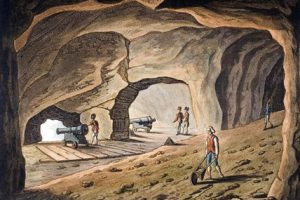
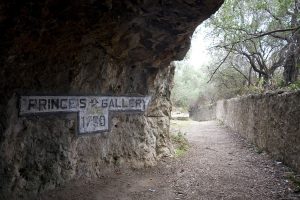 Gibraltar. At the start of World War II, the civilian population around the Rock of Gibraltar was evacuated and the garrison inside the facility was greatly increased in size. A number of new tunnels were excavated to create accommodation for the expanded garrison and to store huge quantities of food, equipment, and ammunition. The work was carried out by four specialized tunneling companies from the Royal Engineers and the Canadian Army. They created a new Main Base Area in the southeastern part of Gibraltar on the peninsula’s Mediterranean coast. It was chosen because it was shielded from the potentially hostile Spanish mainland. New connecting tunnels were created to link this with the established military bases on the west side. A pair of tunnels, called the Great North Road and the Fosse Way, were excavated running nearly the full length of the Rock to interconnect the bulk of the wartime tunnels.
Gibraltar. At the start of World War II, the civilian population around the Rock of Gibraltar was evacuated and the garrison inside the facility was greatly increased in size. A number of new tunnels were excavated to create accommodation for the expanded garrison and to store huge quantities of food, equipment, and ammunition. The work was carried out by four specialized tunneling companies from the Royal Engineers and the Canadian Army. They created a new Main Base Area in the southeastern part of Gibraltar on the peninsula’s Mediterranean coast. It was chosen because it was shielded from the potentially hostile Spanish mainland. New connecting tunnels were created to link this with the established military bases on the west side. A pair of tunnels, called the Great North Road and the Fosse Way, were excavated running nearly the full length of the Rock to interconnect the bulk of the wartime tunnels.
It was to this place that the French Resistance smuggled downed Allied airmen and other escapees from the Nazi regime inside France. Men like Staff Sergeant Arthur Meyerowitz and RAF Bomber Lieutenant R.F.W. Cleaver…two of the men who were smuggled out of occupied France by the French Resistance network known as Réseau Morhange which was created in 1943 by Marcel Taillandier in Toulouse. Taillandier was killed shortly after these two men were smuggled out. He had given his life to protect the airmen he smuggled out as well as to provide intelligence to England. For the airmen who made it to the Rock of Gibraltar, freedom awaited. While 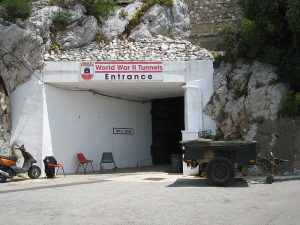
 the road had been long and hard, the time spent at the Rock of Gibraltar meant safety, medical care, food, and warmth. It meant being able to let their family know that they were alive. It meant being able to go back to life, and maybe for some, to be able to live to fight another day. As the men were told upon arrival at the Rock of Gibraltar, “Welcome back to the war.”
the road had been long and hard, the time spent at the Rock of Gibraltar meant safety, medical care, food, and warmth. It meant being able to let their family know that they were alive. It meant being able to go back to life, and maybe for some, to be able to live to fight another day. As the men were told upon arrival at the Rock of Gibraltar, “Welcome back to the war.”
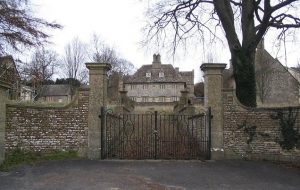 Top secret military bases are common, and have been around longer than most of us would think, but few of them would have been like RAF Rudloe Manor. Most top secret bases had very restricted access, but RAF Rudloe Manor had a way of becoming almost invisible. I’m no expert on top secret bases, and I’m sure that several are underground, but this one struck me as being the best way to hide a military base…ever!! RAF Rudloe Manor is located south-east of Bath. It is just one of several sensitive military installations situated on the Spring Quarries, Copernacre Quarry, the villages of Hawthorn and Hudswell, and the town of Corsham. In World War II the Ministry of Aircraft Production built the Beaverbrook underground aircraft factory here for Bristol Aeroplane and other companies.
Top secret military bases are common, and have been around longer than most of us would think, but few of them would have been like RAF Rudloe Manor. Most top secret bases had very restricted access, but RAF Rudloe Manor had a way of becoming almost invisible. I’m no expert on top secret bases, and I’m sure that several are underground, but this one struck me as being the best way to hide a military base…ever!! RAF Rudloe Manor is located south-east of Bath. It is just one of several sensitive military installations situated on the Spring Quarries, Copernacre Quarry, the villages of Hawthorn and Hudswell, and the town of Corsham. In World War II the Ministry of Aircraft Production built the Beaverbrook underground aircraft factory here for Bristol Aeroplane and other companies.
The area is home to vast caverns, encompassing some 2,250,000 square feet of space, divided into many smaller chambers. Other quarries in the area were expanded and linked together, thereby forming a huge network of tunnels and bunkers. Some parts these tunnels and bunkers were used for army storage purposes.  An RAF Fighter group HQ (RAF Box), and a communications switching center were also set up, making the area an important military nerve center even then. The area also housed the so-called Corsham Computer Centre which while based in Wiltshire, has been alleged to house access to a secret underground city below this English county. Many attempts have been made to gain access to, or at the very least, to confirm of the nature of, this innocent looking facility. Finally, in September of 2000, Sky News was given unprecedented access to this underground city below Wiltshire. The access didn’t specifically mention the Computer Centre as point of entry, however, the news report identified Corsham as the location. As they entered, their camera crews were invited to descend 120 feet below the surface into the previously secret underground city. They saw 60 miles of tunnels, including underground railway stations. Pictures were taken of a recently decommissioned nuclear command bunker. Interestingly, a canteen, which operated in the Second World War, still had murals painted by manufacturing engineers working on the Wellington Bomber engines.
An RAF Fighter group HQ (RAF Box), and a communications switching center were also set up, making the area an important military nerve center even then. The area also housed the so-called Corsham Computer Centre which while based in Wiltshire, has been alleged to house access to a secret underground city below this English county. Many attempts have been made to gain access to, or at the very least, to confirm of the nature of, this innocent looking facility. Finally, in September of 2000, Sky News was given unprecedented access to this underground city below Wiltshire. The access didn’t specifically mention the Computer Centre as point of entry, however, the news report identified Corsham as the location. As they entered, their camera crews were invited to descend 120 feet below the surface into the previously secret underground city. They saw 60 miles of tunnels, including underground railway stations. Pictures were taken of a recently decommissioned nuclear command bunker. Interestingly, a canteen, which operated in the Second World War, still had murals painted by manufacturing engineers working on the Wellington Bomber engines.
They were told that some 4000 personnel were engaged in this secret work at that time. Sky News also transmitted  pictures of massive underground ventilation fans the size of modern jet engines. Why the Government has chosen this moment to disclose this information is anyone’s guess, but the report seemed like a complete U-turn by the military establishment in Wiltshire. Prior to this time, they had remained silent about the claims of underground facilities in this area. As if the act of not talking about it would make the suspicions go away. Still, the very fact that a work-force of 4000 people was able to keep this facility secret for 60 years goes to show how easy it is for Governments to hide their secrets away. And the base looks like just another country manor to this very day.
pictures of massive underground ventilation fans the size of modern jet engines. Why the Government has chosen this moment to disclose this information is anyone’s guess, but the report seemed like a complete U-turn by the military establishment in Wiltshire. Prior to this time, they had remained silent about the claims of underground facilities in this area. As if the act of not talking about it would make the suspicions go away. Still, the very fact that a work-force of 4000 people was able to keep this facility secret for 60 years goes to show how easy it is for Governments to hide their secrets away. And the base looks like just another country manor to this very day.
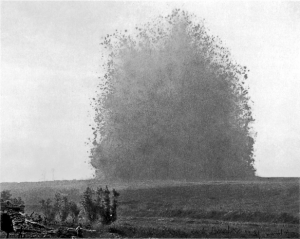 The manner in which battles are fought and won, never ceases to amaze me. In 1916, British forces began planning the Battle of Messines Ridge. For 18 months, soldiers worked to place nearly 1 million pounds of explosives in tunnels under the German positions. The tunnels extended to some 2,000 feet in length, and some were as much as 100 feet below the surface of the ridge, where the Germans had long since been entrenched. The Germans had no idea that they were there, and no idea what was going to happen. I find myself in complete amazement, that all those soldiers were working a mere 100 feet below ground, and the German soldiers above them had no idea. It was the element of surprise that was the whole key to this successful attack.
The manner in which battles are fought and won, never ceases to amaze me. In 1916, British forces began planning the Battle of Messines Ridge. For 18 months, soldiers worked to place nearly 1 million pounds of explosives in tunnels under the German positions. The tunnels extended to some 2,000 feet in length, and some were as much as 100 feet below the surface of the ridge, where the Germans had long since been entrenched. The Germans had no idea that they were there, and no idea what was going to happen. I find myself in complete amazement, that all those soldiers were working a mere 100 feet below ground, and the German soldiers above them had no idea. It was the element of surprise that was the whole key to this successful attack.
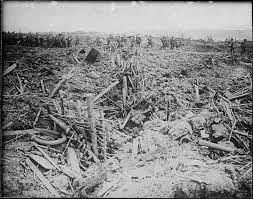 At 3:10am on June 7, 1917, a series of simultaneous explosions rocked the area. The explosions were heard as far away as London. A German observer described the explosions saying, “nineteen gigantic roses with carmine petals, or enormous mushrooms, rose up slowly and majestically out of the ground and then split into pieces with a mighty roar, sending up multi-colored columns of flame mixed with a mass of earth and splinters high in the sky.” While Messines Ridge itself was considered a relatively limited victory, it had a considerable effect. German losses that day included more than 10,000 men who died instantly, along with some 7,000 prisoners…men who were too stunned and disoriented by the explosions to resist the infantry assault.
At 3:10am on June 7, 1917, a series of simultaneous explosions rocked the area. The explosions were heard as far away as London. A German observer described the explosions saying, “nineteen gigantic roses with carmine petals, or enormous mushrooms, rose up slowly and majestically out of the ground and then split into pieces with a mighty roar, sending up multi-colored columns of flame mixed with a mass of earth and splinters high in the sky.” While Messines Ridge itself was considered a relatively limited victory, it had a considerable effect. German losses that day included more than 10,000 men who died instantly, along with some 7,000 prisoners…men who were too stunned and disoriented by the explosions to resist the infantry assault.
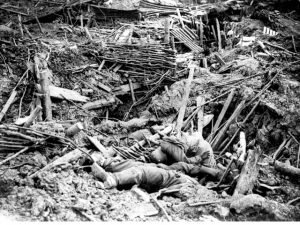
It was a crushing victory over the Germans. The German army was forced to retreat to the east. This retreat and the sacrifice that it entailed marked the beginning of their gradual, but continuous loss of territory along the Western Front. It also secured the right flank of the British army’s push towards the much-contested Ypres region, which was the eventual objective of the planned attack. Over the next month and a half, British forces continued to push the Germans back toward the high ridge at Passchendaele. Then on July 31 the British army launched it’s offensive, known as the Battle of Passchendaele or the Third Battle of Ypres.

